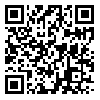Volume 7, Issue 2 (June 2022)
J Environ Health Sustain Dev 2022, 7(2): 1614-1622 |
Back to browse issues page
Download citation:
BibTeX | RIS | EndNote | Medlars | ProCite | Reference Manager | RefWorks
Send citation to:



BibTeX | RIS | EndNote | Medlars | ProCite | Reference Manager | RefWorks
Send citation to:
Ebrahimzadeh Abarghoee S, Halvani G H, Kargar-Shouroki F, Mihanpour H, Madadizadeh F. Job Stress among Workers Exposed to Extremely Low Frequency Electric and Magnetic Fields in a Combined Cycle Power Plant. J Environ Health Sustain Dev 2022; 7 (2) :1614-1622
URL: http://jehsd.ssu.ac.ir/article-1-408-en.html
URL: http://jehsd.ssu.ac.ir/article-1-408-en.html
Sara Ebrahimzadeh Abarghoee 

 , Gholam Hossein Halvani
, Gholam Hossein Halvani 

 , Fatemeh Kargar-Shouroki *
, Fatemeh Kargar-Shouroki * 

 , Hamideh Mihanpour
, Hamideh Mihanpour 

 , Farzan Madadizadeh
, Farzan Madadizadeh 




 , Gholam Hossein Halvani
, Gholam Hossein Halvani 

 , Fatemeh Kargar-Shouroki *
, Fatemeh Kargar-Shouroki * 

 , Hamideh Mihanpour
, Hamideh Mihanpour 

 , Farzan Madadizadeh
, Farzan Madadizadeh 


Occupational Health Research Center, Department of Occupational Health Engineering, School of Public Health, Shahid Sadoughi University of Medical Sciences, Yazd, Iran.
Abstract: (938 Views)
Introduction: Exposure to the low frequency electric and magnetic fields (ELF-EMF) is very common in workers occupied in the combined cycle power plant during work shifts The present study aimed to measure ELF-EMF flux density among shift and non-shift workers, determine job stress among workers and office workers, and identify major factors associated with job stress in the studied groups.
Materials and Methods: In this cross-sectional study, the exposed group was divided into 75 shift workers and 75 non-shift workers. Seventy-five office workers were selected as the reference group. The participants’ exposure to ELF-EMF was measured by the EMF-828 device. In addition, Osipow Occupational Stress Questionnaire was used to assess the participants’ stress levels.
Results: Maximum levels of ELF-EMF among shift workers, non-shift workers, and office workers were 28.67 μT, 23.43 μT, and 0.06 μT, respectively. Although the explosion rate to ELF-EMF was higher in the shift and non-shift workers than the office one's, this rate in both of them were lower than the recommended limit as suggested by the American Conference of Governmental Industrial Hygienists (ACGIH). The highest stress score was related to shift workers exposed to ELF-EMF, in which 42.7% of them experienced moderate to high levels of job stress. Multivariate linear regression analysis showed a significant association between shift work and exposure to ELF-EMF with increased stress.
Conclusion: The findings suggested that exposure to ELF-EMF, even at low intensities, is associated with increased stress. Moreover, Shift work is another risk factor for stress.
Materials and Methods: In this cross-sectional study, the exposed group was divided into 75 shift workers and 75 non-shift workers. Seventy-five office workers were selected as the reference group. The participants’ exposure to ELF-EMF was measured by the EMF-828 device. In addition, Osipow Occupational Stress Questionnaire was used to assess the participants’ stress levels.
Results: Maximum levels of ELF-EMF among shift workers, non-shift workers, and office workers were 28.67 μT, 23.43 μT, and 0.06 μT, respectively. Although the explosion rate to ELF-EMF was higher in the shift and non-shift workers than the office one's, this rate in both of them were lower than the recommended limit as suggested by the American Conference of Governmental Industrial Hygienists (ACGIH). The highest stress score was related to shift workers exposed to ELF-EMF, in which 42.7% of them experienced moderate to high levels of job stress. Multivariate linear regression analysis showed a significant association between shift work and exposure to ELF-EMF with increased stress.
Conclusion: The findings suggested that exposure to ELF-EMF, even at low intensities, is associated with increased stress. Moreover, Shift work is another risk factor for stress.
Type of Study: Original articles |
Subject:
General
Received: 2022/02/17 | Accepted: 2022/04/20 | Published: 2022/06/20
Received: 2022/02/17 | Accepted: 2022/04/20 | Published: 2022/06/20
Send email to the article author
| Rights and permissions | |
 |
This work is licensed under a Creative Commons Attribution-NonCommercial 4.0 International License. |





